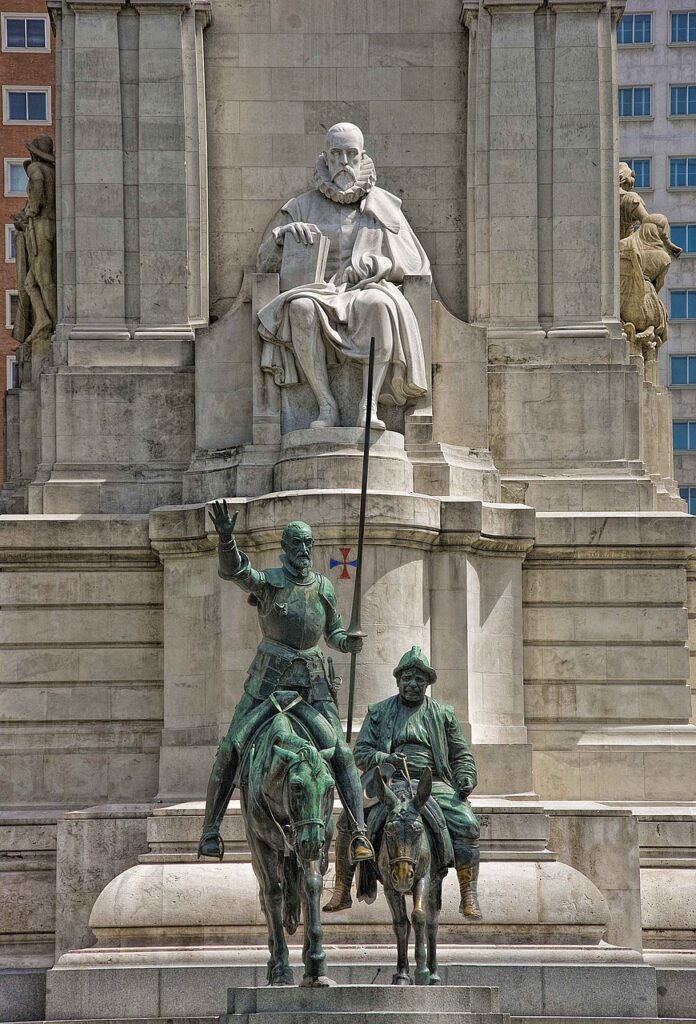Explore More
Don Quixote’s Leadership Qualities: Lessons in Vision, Persistence and Joy
As we celebrate Miguel de Cervantes birthday and his timeless Don Quixote, we explore the world of knights beyond chivalry to discover a blueprint for leadership that resonates today.

While Don Quixote is often read as a parody of outdated chivalric traditions, Miguel de Cervantes’ iconic character embodies several leadership traits that remain highly relevant today. In a world that values innovation, resilience and emotional intelligence, the traits that Don Quixote displays—an active imagination and vision, an unwavering persistence and commitment, and a celebration of life with joy and a sense of humour—are surprisingly modern and worthy of emulation.
Leadership: Imagination and Vision
At the heart of Don Quixote’s character is his visionary imagination. He dares to dream of a world beyond what is immediately visible, constantly reimagining his surroundings to align with his ideals of knighthood and honour. Though often seen as delusional, Quixote’s imagination speaks to a leader’s ability to envision a better future and inspire others to believe in that possibility.
Great leaders throughout history have been those who possess the courage to imagine something new, even in the face of overwhelming doubt. Like Don Quixote, they often start with a vision that seems impossible—whether it’s Gandhi’s dream of a free India, Martin Luther King Jr.’s vision of a racially just society, or Steve Jobs‘ belief in creating technology that changes the way we live. These leaders, like Quixote, are not constrained by the current reality. Instead, they see the world as it could be, and they actively work toward that vision, even when others may mock or misunderstand them.
For modern leaders, Don Quixote’s creative imagination serves as a reminder to cultivate and trust visionary thinking. In a business environment, for example, this could mean developing long-term strategies that anticipate future challenges, embracing innovation, and thinking outside the box. In community leadership, it might involve imagining a more inclusive society and implementing policies that bring that vision to life. While Don Quixote’s dreams may have been far-fetched, his audacity to dream big is a lesson for anyone looking to inspire change and lead with purpose.
Leadership: Persistence and Commitment
Don Quixote’s journey is marked by countless obstacles and failures. From tilting at windmills he mistakes for giants to being ridiculed by those he seeks to protect, Quixote faces continuous adversity. Yet, his persistence never wavers. His commitment to his ideals—no matter how misaligned with reality—shows a depth of resilience that is a hallmark of effective leadership.
In today’s world, leaders are often faced with challenges that test their resolve. Whether it’s navigating economic downturns, leading through crisis, or managing disruptive change, a leader’s ability to remain committed to their goals, even in difficult circumstances, is critical. Don Quixote reminds us that perseverance is key to leadership. While it’s easy to become discouraged by setbacks or failures, great leaders keep moving forward, adapting their approaches while holding on to their core values.
Quixote’s journey also teaches us the importance of a deep-rooted belief in one’s mission. His persistence is fueled not by external rewards or accolades, but by an intrinsic belief in the righteousness of his cause. For modern leaders, this illustrates the power of leading with passion and purpose. Leaders who are truly committed to a cause, whether it’s corporate social responsibility or educational reform, are far more likely to inspire and motivate others than those who are merely going through the motions.
Ultimately, Don Quixote’s persistence is a reminder that success is rarely immediate and that real leadership requires the ability to endure hardships without losing sight of the ultimate goal. In the face of scepticism and failure, it is a leader’s unshakable commitment to their vision that propels them—and their teams—forward.
Leadership: Celebrating of Life with Joy and Sense of Humor
One of the most endearing qualities of Don Quixote is his sense of humour and the joy of celebrating life. While his adventures may seem tragic, they are also deeply comedic, often filled with moments of absurdity and lightheartedness. Don Quixote embraces life fully, never allowing cynicism or despair to dampen his enthusiasm for his quests. This blend of humour and optimism is an important, yet often overlooked, trait in leadership.
A leader who can maintain a sense of humour—even in challenging or tense situations—fosters an environment of positivity and resilience. Humour has been shown to enhance team dynamics, improve communication, and reduce stress in high-pressure environments. In leadership, it serves as a tool to humanise and connect, allowing a leader to build strong relationships with their team members. Dame Neslyn Watson-Druée, DBE explores how your joy and inner child experiences shape your professional relationships and perspectives.
Her latest book offers a unique psychological and reflective approach to understanding and leveraging these influences in your leadership journey. Like Quixote, a leader who can laugh at themselves and embrace the lighter side of life creates a sense of camaraderie, making people feel more at ease and willing to collaborate.
Furthermore, Quixote’s joyful engagement with life reflects the importance of finding meaning and pleasure in the journey, rather than being solely focused on the end result. His adventures—though sometimes misguided—are fueled by a love of life, an appreciation for beauty, and a childlike sense of wonder. For leaders today, this serves as a reminder to celebrate both the small and large victories along the way, and to find joy in the process of leading.
This ability to maintain optimism and celebrate life, even when the odds are against you, is a powerful aspect of leadership. It helps foster resilience, boosts morale, and keeps a team motivated during difficult times. In this way, Don Quixote’s relentless joy and humour provide an invaluable model for modern leaders navigating a complex, often unpredictable world.
Miguel de Cervantes’ Don Quixote offers more than just a satirical look at the world of knights and chivalry; it provides a blueprint for leadership that resonates even today. Through his visionary imagination, persistence in the face of adversity, and lighthearted approach to life, Don Quixote displays qualities that all leaders should seek to emulate.
His active imagination encourages us to think big and embrace visionary thinking, even when it seems impractical. His persistence teaches the value of resilience and commitment to one’s goals, no matter the obstacles. And his celebration of life, marked by a sense of humor, reminds us that leadership is not just about achieving goals, but about enjoying the journey and lifting the spirits of those around us.
In a world that often emphasises practicality and results, Don Quixote’s leadership style is a refreshing reminder that true leaders must also dream, endure and laugh. As we celebrate Miguel de Cervantes and his timeless character, we can all strive to lead with the same daring spirit, relentless commitment and joyful heart that defines the beloved knight of La Mancha.
Celebrating Miguel de Cervantes beyond Don Quixote
On September 29, we celebrate the birthday of one of the most influential figures in literature: Miguel de Cervantes Saavedra. Born in 1547 in Alcalá de Henares, Spain, Cervantes is often regarded as the father of the modern novel, primarily for his magnum opus, Don Quixote. His contribution to literature and his influence on modern storytelling continues to shape the way narratives are constructed and consumed today.
Cervantes’ life was marked by a series of hardships, which shaped much of his writing. After spending his early years in Spain, he enlisted in the military and fought in the Battle of Lepanto in 1571, where he was severely injured, losing the use of his left hand. He referred to this wound as “the glory of the right hand.” This experience, along with his later capture by pirates and subsequent five-year imprisonment in Algiers, introduced him to the theme of captivity, which became a recurring motif in his works.
After his return to Spain, Cervantes faced financial struggles. He worked as a purchasing agent for the Spanish Armada and later as a tax collector, which led to his imprisonment due to irregularities in his accounts. These personal trials and his encounters with the rigid Spanish bureaucracy served as fuel for his satirical commentary on the flaws of society and the nobility.
In 1605, Cervantes published Don Quixote, a novel that would revolutionise literature. Although it initially gained moderate success, it wasn’t until after his death in 1616 that Cervantes’ genius was fully appreciated. The second part of Don Quixote, published in 1615, solidified his legacy as a master storyteller, and today the work is considered one of the greatest books ever written.
Cervantes’ contribution to literature goes far beyond Don Quixote. His novel represents the birth of the modern narrative structure, blending realism with fantasy, satire with sincerity, and making characters multidimensional. The concept of the anti-hero, embodied in the idealistic yet deluded Don Quixote, has had a profound impact on modern storytelling, influencing not only literature but also theatre, film, and television.
Before Don Quixote, literature predominantly featured heroic, idealised characters who performed noble deeds in highly structured narratives. Cervantes broke this mould, introducing a flawed protagonist whose idealism clashed with the harsh realities of the world around him. Don Quixote’s character is simultaneously laughable and admirable, a contradiction that resonates with contemporary audiences who often seek complexity and ambiguity in their heroes.
This template of the anti-hero is evident in characters ranging from Shakespeare’s Hamlet to modern icons like Walter White from Breaking Bad or Tony Soprano from The Sopranos. Cervantes’ exploration of the human psyche and the blurred line between madness and sanity can be traced in the protagonists of countless modern stories, from literature to film.
Cervantes also pioneered the use of satire to critique the social and political structures of his time. Don Quixote lampooned the absurdity of chivalric traditions, pointing out the disconnection between the ideals of the past and the present-day reality. His wit and sharp observations have inspired generations of writers to use humour as a tool for social critique.
Modern satire, from the political cartoons of the 18th century to television shows like Saturday Night Live, owes much to Cervantes’ ability to combine comedy with deeper truths. He demonstrated that humor can be a powerful vehicle for conveying important messages about society’s flaws, a technique that resonates strongly in today’s political and social landscape.
The Birth of Meta-Fiction
Another innovation attributed to Cervantes is his early experimentation with meta-fiction. In the second part of Don Quixote, Cervantes cleverly references the existence of the first part of his novel within the story, and characters react to the notoriety of Don Quixote and Sancho Panza as if they were real people. This self-referential technique, where fiction acknowledges its own artifice, was revolutionary in Cervantes’ time and has become a common literary device in postmodern literature and beyond.
Modern creators like Jorge Luis Borges, Philip Roth, and Charlie Kaufman have expanded on Cervantes’ legacy, using meta-fiction to question the nature of reality, identity, and authorship. Films like Adaptation and novels such as If on a winter’s night a traveller owe their playful narrative structure to Cervantes’ groundbreaking techniques.
Beyond technical innovation, Cervantes’ creation of Don Quixote has seeped into the cultural consciousness. The character has become an archetype for the dreamer, the idealist who fights against impossible odds, regardless of how out of touch with reality they may be. The term “quixotic” is now synonymous with impractical idealism, and the image of a man tilting at windmills, believing them to be giants, has become a universal symbol for the triumph and tragedy of human aspiration.
Today, this archetype inspires everything from literary works to music and art. Picasso’s famous sketches of Don Quixote and Panza are a testament to the character’s enduring power, while operas, ballets, and films continue to retell Cervantes’ timeless story.
Cervantes’ influence is also apparent in modern education, where his works are studied not only for their literary merit but for their historical and philosophical insight. Don Quixote is a staple in literature courses worldwide, used to teach themes of individualism, idealism, and the human condition. Cervantes’ commentary on reality and illusion still sparks debates in classrooms, and his innovations in narrative structure serve as a model for creative writing students.
Cervantes’ works also continue to inspire contemporary adaptations across a range of media. Films, television series, and even graphic novels have been created based on Don Quixote, demonstrating the adaptability of his themes for modern audiences. Each generation finds new meaning in the knight-errant’s quest, reflecting the universal nature of Cervantes’ exploration of human nature.
Miguel de Cervantes is not just a literary figure of the past; his influence permeates modern storytelling, shaping the way we think about heroes, society, and reality itself. His ability to blend humour with humanism, to critique society while embracing its contradictions, and to explore the complexity of human nature has left an indelible mark on the arts and humanities.
As we celebrate his birthday, we recognize Cervantes not only for his contributions to literature but for his timeless insights into the human soul. Through his work, he reminds us that the line between dreams and reality is a fine one and that the pursuit of the impossible, no matter how quixotic, is at the heart of what it means to be human.
Do you want to share your professional opinion and inspire our readers ? YOUR EXPERTISE could be paving the way for a fairer society and progress.





